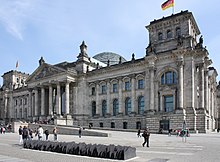Robert Stamm
Robert Stamm (born July 16, 1900 in Remscheid , † November 4, 1937 in Berlin-Plötzensee ) was a German politician , from 1932/33 a member of the Bremen Reichstag for the KPD and a victim of the Nazi regime.
Life
Robert Stamm grew up in a social democratic working class family. During his apprenticeship as a tool fitter and attending the technical school for tool and mechanical engineering, he joined the Spartakus group of Karl Liebknecht and Rosa Luxemburg . In 1919 he joined the KPD and took part in the defensive battles against the Kapp Putsch . From 1924 he worked as an editor and full-time functionary of his party, for which he was a member of the city council of Wuppertal for a while . From 1931 to 1933 he headed the KPD district northwest in Bremen . In July 1932 , Stamm was elected to the Reichstag in the Weser-Ems constituency. In November 1932 and also on March 5, 1933 , he ran successfully, but without being able to exercise the mandate after the last “free” Reichstag election.
On February 7, 1933, Stamm took part in the illegal meeting of the Central Committee of the KPD in the sports store Ziegenhals near Berlin. After the fire in the Reichstag , he went underground, was an instructor for the Hanover district of the KPD until June 1933, and from March to October 1934 the chief of the Berlin-Brandenburg district.
In October 1934, Stamm left Germany and stayed in Moscow in preparation for the VII World Congress of the Communist International . After returning on February 10, 1935, he was arrested by the Gestapo on March 27, 1935 together with Adolf Rembte , Käte Lübeck and Max Maddalena and imprisoned in Berlin-Moabit . On June 4, 1937, Stamm was sentenced to death by the People's Court for “preparing a treasonable undertaking under aggravating circumstances” and, despite international protests, beheaded on the scaffold in the Plötzensee prison yard on November 4, 1937 .
Even before the execution, the Secret State Police Office had spoken out against the transfer of the corpse from Stamm to his relatives: “It must be prevented under all circumstances that high treasoners and treasoners who have been executed are not used or carried on with any kind of cult. Martyrs' cemeteries are to be created ”, according to a Gestapo letter to the Reich Attorney at the People's Court on June 17th.
Commemoration
Since 1992 one of the 96 memorial plaques for members of the Reichstag murdered by the National Socialists has been commemorating Stamm near the Reichstag in Berlin .
literature
- Stamm, Robert . In: Hermann Weber , Andreas Herbst : German Communists. Biographical Handbook 1918 to 1945. 2., revised. and strong exp. Edition. Karl Dietz Verlag, Berlin 2008, ISBN 978-3-320-02130-6 .
- Luise Kraushaar (ed.): German resistance fighters 1933–1945. Biographies and letters. Volume 2. Dietz-Verlag, Berlin 1970, pp. 291-293.
Individual evidence
- ↑ List of participants
- ↑ Martin Schumacher (Ed.): MdR The Reichstag members of the Weimar Republic in the time of National Socialism. Political persecution, emigration and expatriation 1933–1945. Droste-Verlag, Düsseldorf 1991, ISBN 3-7700-5162-9 , pp. 557f.
- ↑ Quoted in Schumacher, MdR , p. 558.
Web links
- Short biography of the German Resistance Memorial Center
- Short biography with photo of the Ziegenhals memorial
- Robert Stamm in the database of members of the Reichstag
- Günter Konrad, Klaus-Günther Conrads: Robert Stamm (PDF). In: ronsdorfer-buergerverein.de. Retrieved February 1, 2016 .
| personal data | |
|---|---|
| SURNAME | Stamm, Robert |
| BRIEF DESCRIPTION | German politician (KPD), MdR, victim of the Nazi regime |
| DATE OF BIRTH | July 16, 1900 |
| PLACE OF BIRTH | Remscheid |
| DATE OF DEATH | November 4, 1937 |
| Place of death | Berlin-Plötzensee |

